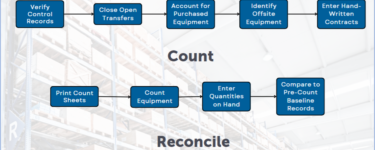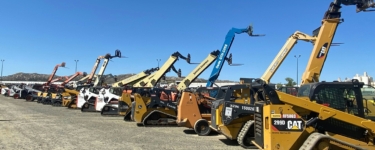How to Track Your Rental Inventory More Efficiently as Your Business Grows
Renting out 10 pieces of equipment is one thing. Managing hundreds – if not thousands – of assets? That’s a whole different ballgame. You can’t just look at your yard and see if a machine is there. As you open new locations, acquire smaller companies, and expand your fleet, staying organized is crucial. Jeff Loomis, InTempo’s Director of Business Development, shares his tips for efficiently tracking your rental inventory as your company grows.
Diligently Maintain Your Rental Inventory Management System
After a certain point – usually a few dozen pieces of equipment – manual inventory tracking just doesn’t cut it. It’s not just time-consuming; it’s too easy to forget to update a spreadsheet or whiteboard, and the lack of visibility puts you at an immediate disadvantage.

Of course, even the best rental inventory software won’t manage itself. You have to make sure all your employees are diligent about using it correctly.
“You have to be able to trust your system of record. As you grow into a multi-location rental company – whether you’re renting industrial equipment, construction equipment, power tools, A/V equipment, or something else entirely – you can’t leave anything to chance. Your employees have to base their decisions on one single ‘source of truth’. If that source of truth says you have 3 42’-45’ forklifts and 2 of them are out on rent, that’s the information you have to base your decisions on.
If one store isn’t diligent about updating that source of truth, your inventory records won’t be accurate. Train everyone on the required procedures for tracking your rental inventory and re-train them again as often as needed.
It seems obvious, but make sure you’re keeping up with equipment statuses. If a recently returned loader is in the shop or on the wash rack, it can’t go back out to another customer until it’s ready.
Similarly, make sure your sales reps and counter employees create a reservation as soon as a unit has been committed to a customer. If a unit has been committed but there’s no reservation, it can be easily promised to someone else, and that’s where double-bookings occur.”
Jennifer Heckel, InTempo’s Customer Success Manager, recalls an approach that she used in her time at a 35-location specialty truck supplier.
“We reviewed our reservations every day. If there was a reservation without a purchase order, we’d release it and let the customer know that we needed a PO to put that truck on hold – especially during periods of peak demand. Otherwise, we couldn’t keep it in limbo.”
Run Regular Physical Inventories to Verify Your Inventory Counts
Even with diligent updates, inventory records still need regular verification. Small sales items can get broken and thrown away or stolen; attachments can be accidentally left at a customer’s jobsite; branch-to-branch transfers may slip through the cracks. Regular physical stock counts confirm that your inventory records match your quantity on hand. This helps prevent overstocks and stock-outs.

Use Cycle Counts to Break the Process Down Into More Manageable Pieces
A complete stock count may require shutting down an entire location for a day or two. There are several steps you can take to speed up the physical inventory process, but it can still cause a major disruption to your rental business.
Cycle counts let you break the process down into more manageable pieces. You can count a small portion of your parts, merchandise, or equipment each day until you’ve gone through everything you have on hand. When you’ve gone through everything, you start back again at the top. This lets you track your rental inventory on an ongoing basis. You can quickly identify – and resolve – discrepancies before they impact reservations or sales.
Standardize Your Inventory Records Starting on Day One
Ask three employees to set up a new piece of equipment and all three are likely to do it differently. A Manitowoc MLC80A-1 may go in as “Manitowoc Lattice-Boom Crawler MLC80A1”, “Manitawac mlc80a1”, and “MLC80A-1 crawler crane”. Instead of having three of the same item show as available, you’ll see one available for each of three separate items. Needlessly messy and confusing – but easily avoidable.
“We enforced user permissions to allow only one employee to submit new items to inventory,” Jennifer shares. “Of course, if that person was out on vacation, we’d have a backup plan in place, but we’d have the primary user review those newly added items when they came back to make sure the formatting was consistent. This made it much easier to track our rental inventory across the board.”
Be Strategic When Introducing Acquisitions to Your Inventory Software
If you’re running one inventory system but acquire a rental business that’s currently using different software, clean up and re-standardize the data before you migrate it to your corporate platform. Don’t just check for naming conventions; go as far as your category/class level and make sure all records match as you bring the new acquisition onto your core system.
Learn How to Track Your Rental Inventory More Efficiently as Your Business Grows
At InTempo, we’ve helped hundreds of independent rental companies successfully grow their businesses. With a focus on local and regional development, we know exactly what it takes to scale without the resources of a national chain. Whether you need help standardizing your processes, keeping a closer eye on your rental inventory, or deciding how to strategically grow your fleet, we’re here to help. Take a deeper look at our easy-to-use rental inventory software or contact our team to learn more.
 Faith Kubicki
Faith Kubicki

